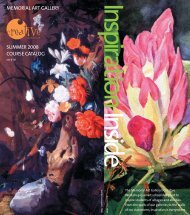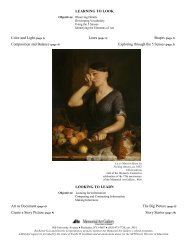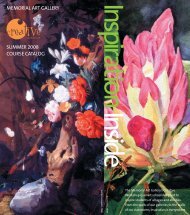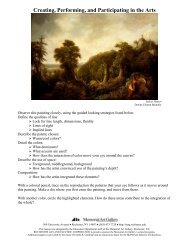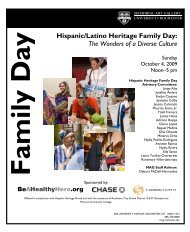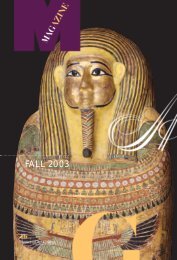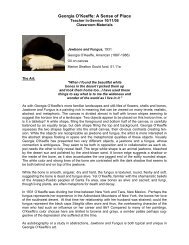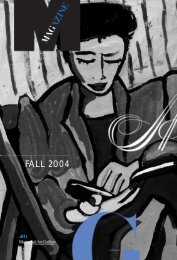Tradition in Transition: Russian Icons in the Age of the Romanovs
Tradition in Transition: Russian Icons in the Age of the Romanovs
Tradition in Transition: Russian Icons in the Age of the Romanovs
You also want an ePaper? Increase the reach of your titles
YUMPU automatically turns print PDFs into web optimized ePapers that Google loves.
A Curatorial Conundrum<br />
The Puzzle <strong>of</strong> MAG’s St. George Slay<strong>in</strong>g <strong>the</strong> Dragon<br />
by Nancy Norwood<br />
Curator <strong>of</strong> European Art, MAG<br />
St. George and Russia<br />
Based on style, color, and formal characteristics, <strong>the</strong> icon St. George Slay<strong>in</strong>g <strong>the</strong> Dragon<br />
entered MAG’s collection as orig<strong>in</strong>at<strong>in</strong>g <strong>in</strong> <strong>the</strong> mid-1300s from <strong>the</strong> <strong>Russian</strong> city <strong>of</strong> Novgorod.<br />
As <strong>the</strong> patron sa<strong>in</strong>t <strong>of</strong> Moscow and <strong>of</strong> <strong>the</strong> <strong>Russian</strong> pr<strong>in</strong>ces, St. George played a special role<br />
<strong>in</strong> Orthodox religious practice and was a frequent subject <strong>of</strong> icon pa<strong>in</strong>t<strong>in</strong>gs. Accord<strong>in</strong>g to<br />
Christian tradition, George, who was born dur<strong>in</strong>g <strong>the</strong> third century <strong>in</strong>to a Christian family,<br />
jo<strong>in</strong>ed <strong>the</strong> Roman army. Dur<strong>in</strong>g his travels, he came across a city that was be<strong>in</strong>g terrorized<br />
by a dragon. At <strong>the</strong> moment <strong>of</strong> George’s arrival, <strong>the</strong> dragon, who had already eaten all<br />
<strong>of</strong> <strong>the</strong> farm animals and had begun to consume <strong>the</strong> townspeople, was prepar<strong>in</strong>g to swallow<br />
<strong>the</strong> k<strong>in</strong>g’s daughter. With <strong>the</strong> help <strong>of</strong> Christ, George overcame <strong>the</strong> dragon and killed him<br />
with his spear, thus sav<strong>in</strong>g <strong>the</strong> city from ru<strong>in</strong>. He later became a sa<strong>in</strong>t when he was martyred<br />
by <strong>the</strong> Romans for his Christian beliefs.<br />
The most popular depiction <strong>of</strong> St. George <strong>in</strong> <strong>Russian</strong> icons represents his struggle with <strong>the</strong><br />
dragon, a scene that also represents <strong>the</strong> victory <strong>of</strong> Good over Evil. MAG’s St. George<br />
follows <strong>the</strong> iconography prevalent among icon pa<strong>in</strong>ters <strong>in</strong> <strong>the</strong> city <strong>of</strong> Novgorod, where<br />
<strong>the</strong> sa<strong>in</strong>t was particularly admired. Cloaked <strong>in</strong> a red mantle and mounted on a white horse,<br />
George stabs <strong>the</strong> dragon directly through <strong>the</strong> mouth with his spear as <strong>the</strong> dragon’s body<br />
is trampled by <strong>the</strong> horse’s hooves. A protective angel hovers near George’s head, while<br />
<strong>the</strong> hand <strong>of</strong> God reaches toward him from <strong>the</strong> upper right corner <strong>of</strong> <strong>the</strong> pa<strong>in</strong>t<strong>in</strong>g. The red<br />
color <strong>of</strong> <strong>the</strong> cloak symbolizes <strong>the</strong> blood <strong>of</strong> martyrdom; <strong>the</strong> white horse represents Div<strong>in</strong>e<br />
Light. The small images <strong>of</strong> sa<strong>in</strong>ts that appear on <strong>the</strong> left and right sides also suggest<br />
Novgorod as <strong>the</strong> place <strong>of</strong> orig<strong>in</strong>, as patrons <strong>the</strong>re frequently commissioned icons with<br />
sa<strong>in</strong>ts who held special personal significance. Those sa<strong>in</strong>ts served as protectors <strong>of</strong> both<br />
<strong>the</strong> <strong>in</strong>dividual patron and <strong>the</strong> icon itself.<br />
Courtesy <strong>Russian</strong> Museum, St. Petersburg. Courtesy Hillwood Museum & Gardens Wash<strong>in</strong>gton, D.C. Courtesy State Tretyakova Gallery, Moscow. Courtesy <strong>Russian</strong> Museum, St Petersburg.


